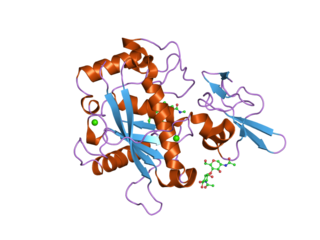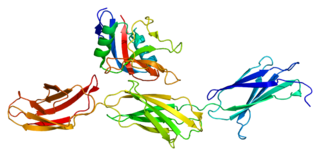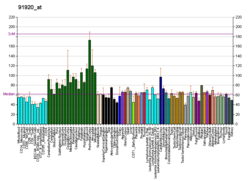
A disintegrin and metalloproteinase with thrombospondin motifs 5 also known as ADAMTS5 is an enzyme that in humans is encoded by the ADAMTS5 gene.

Versican is a large extracellular matrix proteoglycan that is present in a variety of human tissues. It is encoded by the VCAN gene.

Aggrecan (ACAN), also known as cartilage-specific proteoglycan core protein (CSPCP) or chondroitin sulfate proteoglycan 1, is a protein that in humans is encoded by the ACAN gene. This gene is a member of the lectican family. The encoded protein is an integral part of the extracellular matrix in cartilagenous tissue and it withstands compression in cartilage.

A disintegrin and metalloproteinase with thrombospondin motifs 4 is an enzyme that in humans is encoded by the ADAMTS4 gene.

DNA-binding protein inhibitor ID-1 is a protein that in humans is encoded by the ID1 gene.

Syndecan-3 is a protein that in humans is encoded by the SDC3 gene.

Chondroitin sulfate proteoglycan 4, also known as melanoma-associated chondroitin sulfate proteoglycan (MCSP) or neuron-glial antigen 2 (NG2), is a chondroitin sulfate proteoglycan that in humans is encoded by the CSPG4 gene.

Hyaluronan and proteoglycan link protein 1 is a protein that in humans is encoded by the HAPLN1 gene.

Proteoglycan 4 or lubricin is a proteoglycan that in humans is encoded by the PRG4 gene. It acts as a joint/boundary lubricant.

Fibromodulin is a protein that in humans is encoded by the FMOD gene.

Xylosyltransferase 1 is an enzyme that in humans is encoded by the XYLT1 gene.

Neurocan core protein is a protein that in humans is encoded by the NCAN gene.

Glucocorticoid receptor DNA-binding factor 1 is a protein that in humans is encoded by the GRLF1 gene.

Galactosylgalactosylxylosylprotein 3-beta-glucuronosyltransferase 3 is an enzyme that in humans is encoded by the B3GAT3 gene.

Xylosyltransferase 2 is an enzyme that in humans is encoded by the XYLT2 gene.

Asporin is a protein that in humans is encoded by the ASPN gene.

Chondroitin sulfate proteoglycan 5 is a protein that in humans is encoded by the CSPG5 gene.

Girdin is a protein that in humans is encoded by the CCDC88A gene. Although its cellular function are not fully elucidated, it has been associated with glioma.

Tenascin-R is a protein that in humans is encoded by the TNR gene.

Hyaluronan and proteoglycan link protein 2 (HAPLN2) also known as brain link protein 1 (BRAL1) is a protein that in humans is encoded by the HAPLN2 gene. HAPLN1 codes for a related link protein that is expressed in cartilage while Bral1 is expressed in brain.






















